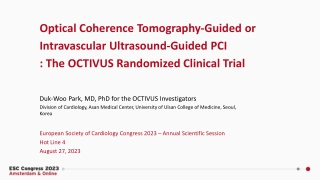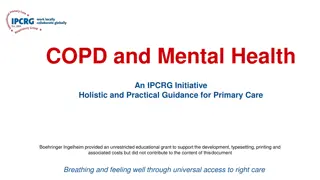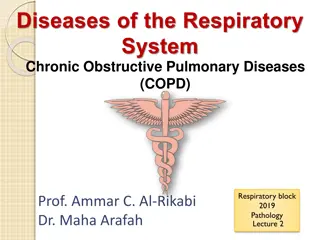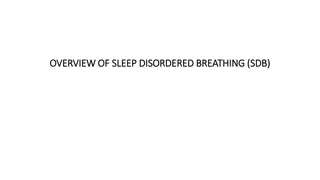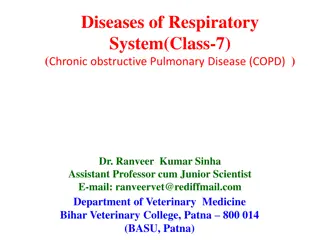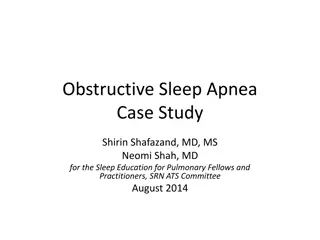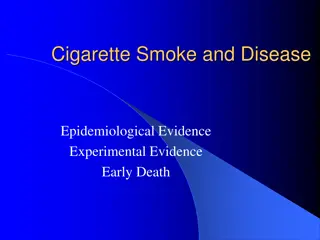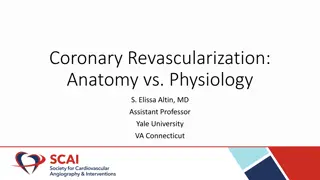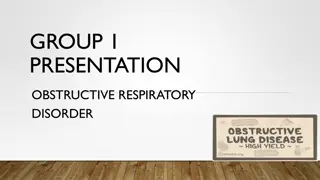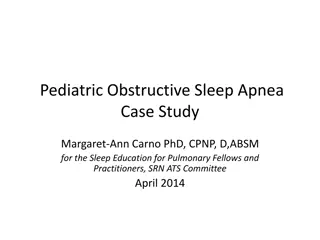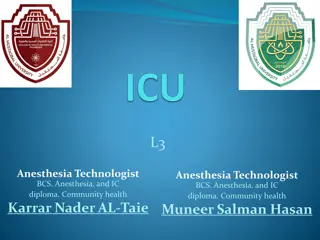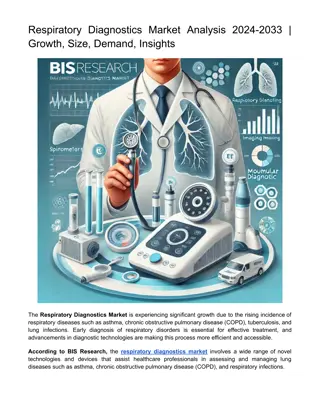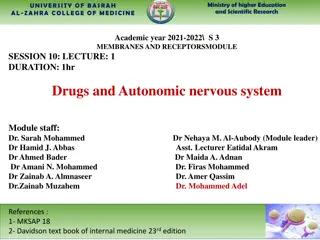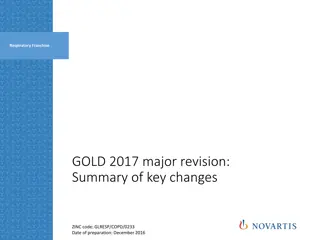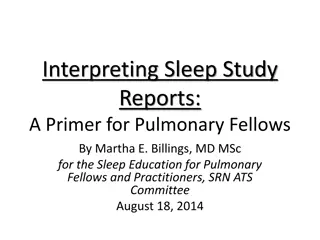OCTIVUS Randomized Clinical Trial: OCT-Guided vs IVUS-Guided PCI
The OCTIVUS Randomized Clinical Trial compared the clinical efficacy and safety of Optical Coherence Tomography (OCT)-guided and Intravascular Ultrasound (IVUS)-guided strategies in patients undergoing PCI for significant CAD. The study aimed to determine if OCT-guided PCI is noninferior to IVUS-gui
8 views • 27 slides
Multidisciplinary Approach to Bariatric Surgery: Case Study and Interventions
This case study involves a patient with severe obesity and comorbidities preparing for bariatric surgery. The medical history includes type 2 diabetes and significant obstructive sleep apnea, leading to a reduced quality of life. The patient's psychosocial assessment highlights the importance of psy
4 views • 7 slides
The Link Between Sleep and Health_ Exploring Obstructive Sleep Apnea Screening
Everyone needs a good night\u2019s sleep but not everyone gets it. While the general population is generally plagued with various sleep conditions, one of the most common ones is obstructive sleep apnea.
7 views • 4 slides
Comprehensive Guidance on COPD and Mental Health in Primary Care
This document, supported by an educational grant, offers holistic guidance on managing chronic obstructive pulmonary disease (COPD) and mental health in primary care settings. It includes case studies, glossary of terms, and practical information for healthcare professionals to provide optimal care
0 views • 27 slides
Understanding Chronic Obstructive Pulmonary Diseases (COPD) and Emphysema
Chronic Obstructive Pulmonary Diseases (COPD) encompass conditions like chronic bronchitis and emphysema, typically caused by factors like cigarette smoking. This presentation delves into the clinical and functional variances between chronic bronchitis and emphysema in COPD patients, along with an e
1 views • 40 slides
Overview of Shock Classifications and Causes
Shock is classified into different types such as Hypovolemic, Cardiogenic, Obstructive, Distributive, and Endocrine shock. Hypovolemic shock results from fluid loss, while Cardiogenic shock is due to heart failure. Obstructive shock occurs from mechanical obstructions, whereas Distributive shock is
1 views • 11 slides
Understanding Sleep Disordered Breathing (SDB) and Sleep Apnea
Sleep Disordered Breathing (SDB) encompasses various breathing difficulties during sleep, including Obstructive Sleep Apnea (OSA) and Central Sleep Apnea. These disorders can lead to serious health issues but are manageable. OSA, a common type of SDB, poses risks to cardiovascular and cerebrovascula
0 views • 21 slides
Clinical Documentation Case Study: Posterior Fossa Syndrome and Mutism in Pediatric Patient
A case study of Kaye, a 3-year-old with a posterior fossa mass and obstructive hydrocephalus, highlights the importance of accurate clinical documentation. CDI queries to the physician clarified the distinction between posterior fossa mutism and syndrome, impacting coding accuracy and patient care o
4 views • 11 slides
Chronic Obstructive Pulmonary Disease (COPD) in Horses: A Veterinarian's Perspective
Chronic Obstructive Pulmonary Disease (COPD) in horses is a respiratory condition caused by hypersensitivity reactions to allergens, viral infections, or bronchopneumonia. This chronic respiratory disease leads to decreased work performance, chronic coughing, abnormal lung sounds, and cardiac dysfun
0 views • 17 slides
Understanding Obstructive Sleep Apnea: A Comprehensive Case Study
This case study presents Mr. Simon Applegate, a 55-year-old male experiencing symptoms suggestive of obstructive sleep apnea (OSA). Key aspects include his medical history, physical exam findings, and sleep-related complaints reported by his wife. Important components of a good sleep history, differ
0 views • 15 slides
Understanding the Links Between Cigarette Smoke and Disease
Epidemiological and experimental evidence clearly show the devastating impact of smoking on health, leading to diseases like lung cancer and Chronic Obstructive Pulmonary Disease. Statistics reveal the alarming risks associated with smoking, emphasizing the urgent need for smoking cessation. Researc
0 views • 17 slides
Understanding Coronary Revascularization: Anatomy vs. Physiology
This content discusses the prevalence of angina in women compared to men, the importance of stable angina in predicting outcomes, the need for better diagnostic methods for coronary angiography, and the differences in obstructive CAD by sex and ethnicity in stable angina cases. It highlights the cha
0 views • 22 slides
Overview of Common Sleep Disorders and Their Classification
Sleep disorders such as insomnia, restless leg syndrome, obstructive sleep apnea, parasomnias, and narcolepsy are prevalent conditions that affect the quality and pattern of sleep. Insomnia is characterized by difficulty initiating or maintaining sleep and is more common in females and older individ
0 views • 33 slides
Understanding Sleep Disorders: Classification and Diagnosis
Sleep disorders encompass various conditions affecting sleep patterns and quality. They are classified into categories such as insomnia, sleep-related breathing disorders, central disorders of hypersomnolence, circadian rhythm sleep-wake disorders, parasomnias, and sleep-related movement disorders.
0 views • 32 slides
Benefits of Bariatric Surgery for Obesity Patients
Bariatric surgery is a highly effective treatment for obesity, offering significant improvements in comorbidities such as diabetes, hyperlipidemia, and hypertension. Studies show that the surgery resolves conditions like obstructive sleep apnea and gastroesophageal reflux, leading to improved qualit
0 views • 52 slides
Understanding Pulmonary Emphysema: Symptoms, Causes, and Pathophysiology
Pulmonary emphysema, a type of obstructive respiratory disorder, is a progressive lung disease that affects the air spaces in the lungs. This condition is primarily caused by long-term exposure to irritants like tobacco smoke and air pollution. The damage to the alveoli leads to symptoms such as sho
0 views • 49 slides
Pulmonary Abnormalities and Their Physiologic Effects
Chronic pulmonary emphysema is a complex obstructive and destructive lung condition typically caused by smoking. It leads to chronic infection, excessive mucus production, airway obstruction, and lung tissue destruction. The physiological effects of emphysema include hypoxia, hypercapnia, and severe
0 views • 12 slides
Understanding Obstructive and Restrictive Lung Diseases
Explore the differences between obstructive and restrictive lung diseases through detailed images and descriptions of upper airway obstructions, intrathoracic versus extrathoracic limitations, and how to interpret flow-volume loops. Learn about common conditions like COPD and asthma affecting inspir
0 views • 36 slides
Pediatric Obstructive Sleep Apnea Case Study: Diagnosis and Management
This case study revolves around a 6-year-old African American male initially diagnosed with asthma but still experiencing persistent snoring, headaches, and restlessness. Through a detailed examination, the healthcare provider explores the possibility of pediatric obstructive sleep apnea (OSA) and d
0 views • 22 slides
Understanding Mechanical Ventilation in Anesthesia Technology
Mechanical ventilation plays a crucial role in assisting patients with breathing difficulties by delivering oxygen and removing carbon dioxide. It involves two primary types: Negative Pressure Ventilation (NPV) and Positive Pressure Ventilation (PPV). NPV helps patients with conditions like chronic
0 views • 19 slides
Respiratory Diagnostics Market Analysis 2024-2033
The respiratory diagnostics market involves a wide range of novel technologies and devices that assist healthcare professionals in assessing and managing lung diseases such as asthma, chronic obstructive pulmonary disease (COPD), and respiratory infe
1 views • 3 slides
Understanding Autonomic Nervous System and Clinical Applications in Medicine
This academic session covers the effect of autonomic nervous system stimulation on various systems, clinical diseases, pathophysiological changes, disease management guidelines, and clinical applications of autonomic drugs. Common clinical applications of autonomic receptors agonists and antagonists
0 views • 23 slides
Enhancing Care for Long-Term Care Residents Through Early Detection and Intervention
This collection of resources highlights the importance of identifying acute changes in long-term care (LTC) residents, focusing on potentially preventable conditions such as chronic obstructive pulmonary disease, urinary tract infections, pneumonia, and heart failure. It underscores the risks associ
0 views • 25 slides
Understanding Shock: Types, Causes, and Classification
Shock is a complex condition resulting from an imbalance between oxygen delivery and consumption in the body. It can be caused by various insults and classified into different types such as hypovolaemic, cardiogenic, obstructive, and distributive. Each type has specific causes and manifestations, co
0 views • 32 slides
GOLD 2017 Major Revisions in COPD Management
GOLD 2017 introduces significant changes in Chronic Obstructive Pulmonary Disease (COPD) management, focusing on areas like defining COPD, assessment tools, pharmacological management, inhaler techniques, and comorbidity management. The updated definition emphasizes persistent respiratory symptoms.
0 views • 17 slides
Understanding Criteria and Interpretation of Sleep Study Reports
This primer delves into the nuances of obstructive sleep apnea, defining terms like apnea and hypopnea, and discussing the AHI, RDI, and scoring criteria for respiratory events. It explains the significance of PSG in evaluating respiratory data, oximetry results, and EEG data during sleep studies. T
0 views • 23 slides
